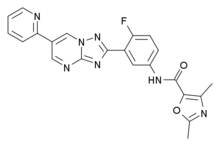GNF6702
Jump to navigation
Jump to search
 | |
| Identifiers | |
|---|---|
| |
| CAS Number | |
| PubChem CID | |
| ChemSpider | |
| UNII | |
| ChEBI | |
| Chemical and physical data | |
| Formula | C22H16FN7O3 |
| Molar mass | 445.414 g·mol−1 |
| 3D model (JSmol) | |
| |
| |
GNF6702 is the name for a broad-spectrum antiprotozoal drug invented by researchers working at the Genomics Institute of the Novartis Research Foundation in 2013,[1] with activity against leishmaniasis, Chagas disease and sleeping sickness. These three diseases are caused by related kinetoplastid parasites, which share similar biology. GNF6702 acts as allosteric proteasome inhibitor which was effective against infection with any of the three protozoal diseases in mice, while having little evident toxicity to mammalian cells.[2]
See also
References
- ^ US 2015175613, Biggart A, et al., "Compounds and compositions for the treatment of parasitic diseases", published 25 June 2015, assigned to Novartis AG
- ^ Khare S, Nagle AS, Biggart A, Lai YH, Liang F, Davis LC, et al. (September 2016). "Proteasome inhibition for treatment of leishmaniasis, Chagas disease and sleeping sickness". Nature. 537 (7619): 229–233. Bibcode:2016Natur.537..229K. doi:10.1038/nature19339. PMC 5161665. PMID 27501246.
Categories:
- Articles with short description
- Short description matches Wikidata
- Chemical pages without DrugBank identifier
- Articles without KEGG source
- Drugs missing an ATC code
- Drugs with no legal status
- Articles containing unverified chemical infoboxes
- Antiprotozoal agents
- Carboxamides
- 2-Pyridyl compounds
- Oxazoles
- All stub articles
- Antiinfective agent stubs